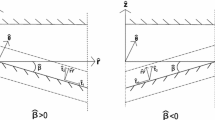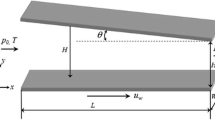Abstract
Reliable high-performance bearings are essential in rotordynamics. As speeds and loads are continuously increased, the demands on bearing technology grow simultaneously. Detailed calculations of bearing characteristics become more important under these circumstances. In this work, a generalized Reynolds equation for analysing thin film lubrication problems is presented. The equation describes the flow of compressible fluids in arbitrary narrow gaps with general boundary conditions. As an application for this equation, we consider the double-sided spiral groove thrust bearing. A CFD calculation is performed to validate the generalized Reynolds equation derived here. On the basis of a particle swarm optimization method, optimal geometrical bearing parameters are identified. Performance charts for optimized bearing configurations with respect to load carrying capacity and friction coefficient are delivered.




















Similar content being viewed by others
References
Bonneau, A., Huitric, J., Tournerie, B.: Finite element analysis of grooved gas thrust bearings and grooved gas face seals. Trans. ASME 115, 348–355 (1993)
Boyaci, A., Seemann, W., Proppe, C.: Nonlinear stability analysis of rotor-bearing systems. PAMM Proc. Appl. Math. Mech. 9, 279–280 (2009). doi:10.1002/pamm.200910113
Boyaci, A., Steinhilber, G., Seemann, W., Proppe, C.: Zur Stabilität eines in Gleitlagern laufenden elastischen Rotors, SIRM 2009 - 8th International Conference on Vibrations in Rotating Machines, Paper-ID 18, Vienna, Austria, 23 - 25 February 2009, ISBN 978-3-200-01412-1
Boyaci, A., Hetzler, H., Seemann, W., Proppe, C., Wauer, J.: Analytical bifurcation analysis of a rotor supported by floating ring bearings, Nonlinear Dynamics, doi:10.1007/s11071-008-9403-x
Bruckner, R.: Simulation and modeling of the hydrodynamic, thermal, and structural behavior of foil thrust bearings, PHD Thesis, Case Western Reverse University, USA, (2004), https://etd.ohiolink.edu/
Childs, D.: Turbomachinery Rotordynamics. Wiley, New York (1993)
Daniel, C., Strakeljan, J., Woschke, E.: Modellierung von Gleitlagern in rotordynamischen Modellen SIRM 2009 - 8th International Conference on Vibrations in Rotating Machines, Vienna, Austria, 23–25 February 2009
Daniel, C.; Göbel, S.; Nitzschke, S.; Woschke, E.; Strackeljan, J.: Numerical Simulation of the Dynamic Behaviour of Turbochargers under Consideration of Full-Floating-Ring Bearings and Ball Bearings 11th International Conference on Vibration Problems, Z. Dimitrovov et.al. (eds.), Lisbon, Portugal, 912 September 2013
DellaCorte, C., Zaldana, R., Radil, K.: A systems approach to the solid lubrication of foil air bearings for oil-free turbomachinery. J. Tribol. 126, 200–207 (2004)
Dowson, D.: A generalized Reynolds equation for fluid-film lubrication. Int. J. Mech. Sol. Pergamon Press Ltd. 4, 159–170 (1962)
Dykas, B.: Factors Influencing the Performance of Foil Gas Thrust Bearings for Oil-Free Turbomachinery Applications, PHD Thesis, Case Western Reverse University, USA, (2006), https://etd.ohiolink.edu/
Fischer, J., Strakeljan, J.: A nonlinear numerical simulation of a lab centrifuge with internal damping. Nonlinear Dyn. 60, 3947 (2010). doi:10.1007/s11071-009-9578-9
Yemelyanov, A., Yemelyanov, I.: Theory of binary spiral-grooved gas bearings. Fluid Dyn. 35, 351–360 (2000)
Engelbrecht, A.P.: Fundamentals of Computational Swarm Intelligence. Wiley, New York (2005)
Hamrock, B., Schmid, S., Jacobson, B.: Fundamentals of Fluid Film Lubrication. Dekker, New York City (2004)
Hashimoto, H., Namba, T.: Optimization of groove geometry for a thrust air bearing according to various objective functions. J. Tribol. 131, 041704-1–041704-10 (2009)
Hashimoto, H., Ochiai, M., Nanba, T.: Theoretical analysis and optimum design of high speed air film thrust bearings. J. Adv. Mech. Des. Syst. Manuf. 1, 306–318 (2007)
James, D., Potter, A.: Numerical analysis of the gas-lubricated spiral-groove thrust bearing-compressor. J. Lubr. Tech. 89(4), 439–443 (1967)
Khonsari, M., Booser, E.: Applied Tribology: Bearing Design and Lubrication. Wiley, New York (2008)
Lu, X.; Khonsari, M.M.: An experimental study of oil-lubricated journal bearings undergoing oscillatory motion. J. Tribol. Trans. ASME. 130(2), 021702-1–021702-7 (2008)
Malanoski, S., Pan, C.: The static and dynamic characteristics of the spiral-grooved bearing, transactions of the ASME. J. Basic Eng. 87, 547–558 (1965)
Muijderman, E.: Spiral Groove Bearings, PhD thesis, University Delft, (1964)
Muszynska, A.: Rotordynamics. Taylor and Francis, United Kingdom (2005)
Myers, C.J.: Bifurcation theory applied to oil whirl in plain cylindrical journal bearings. ASME J. Appl. Mech. 51, 244–250 (1984)
Reynaerts, D.; Van Den Braembussche, J.; Hendrick, P.; and others: Development of a gas turbine with a 20 mm rotor: review and perspectives, The Sixth International Workshop on Micro and Nanotechnology for Power Generation and Energy Conversion Applications, November 29–December 1, (2006), Berkeley, USA
Schweizer, B., Sievert, M.: Nonlinear oscillations of automotive turbocharger turbines. J. Sound Vib. 321, 955–975 (2009)
Schweizer, B.: Total instability of turbocharger rotors—physical explanation of the dynamic failure of rotors with full-floating ring bearings. J. Sound Vib. 328, 156–190 (2009)
Schweizer, B.: Dynamics and stability of turbocharger rotors. Arch. Appl. Mech. 80, 1017–1043 (2010)
Sedlaczek, K.; Eberhard, P.: Constrained particle swarm optimization of mechanical systems. In: Proceedings of the 6th WCSMO, Rio de Janeiro, Brazil
Shaw, J., Shaw, S.W.: The effects of unbalance on oil whirl. Nonlinear Dyn. 1, 293–311 (1990)
Vleugels, P.; Waumans, T.; Peirs, J.; Al Bender, F.; Reynaerts, D.: High-speed foil bearings for micro gas turbines: test set-up, The Sixth International Workshop on Micro and Nanotechnology for Power Generation and Energy Conversion Applications, November 29–December 1, (2006), Berkeley, USA
Waters, D.: The American gas centrifuge: past, present, and future, 8. workshop on separation phenomena in liquids and gases (SPLG 2003), Oak Ridge, TN (US), 12–16 October 2003
Whipple, R.: Theory of the spiral grooved thrust bearing with liquid or gas lubricant. Technical report, Atomic Energy Research Establishment, Harwell, Berkshire, England, T/R 622, (1951)
Xue, Y., Stolarski, T.: Numerical prediction of the performance of gas-lubricated spiral groove thrust bearings. J. Eng. Tribol. 211, 117–128 (1997)
Yemelyanov, A., Yemelyanov, I.: Physical models, theory and fundamental improvement to self-acting spiral-grooved gas bearings and visco-seals. In: Proceedings of the Institution of Mechanical Engineers 213, (1999)
Ying, G., Meng, G., Jing, J.: Turbocharger rotor dynamics with foundation excitation. Arch. Appl. Mech. 79(4), 287–299 (2009)
Zhao, S., Wallaschek, J.: Design and Modeling of A Novel Squeeze Film Journal Bearing Proceedings of the 2009 IEEE International Conference on Mechatronics and Automation August 9–12, Changchun, China
Zhao, S., Wallaschek, J.: Experimental Investigations of Ultrasonic Levitation in A Machine Tool Spindle System, Ultrasonics Symposium (IUS), IEEE International. (2009). doi:10.1109/ULTSYM.2009.5441680
Author information
Authors and Affiliations
Corresponding author
Appendix A : details of the derivation of the two-sided generalized Reynolds equation
Appendix A : details of the derivation of the two-sided generalized Reynolds equation
In Sect. 2.1, the derivation of the two-sided generalized Reynolds equation has been outlined. Here, the relevant steps to derive Eq. (11) starting from Eq. (9) are presented in detail. Applying to the second and third term of Eq. (9) in the general relation
we get
Splitting into two terms, expression I can be rewritten as
Applying the product rule to the second term of \(I_A\) results in
Next, we are going to rewrite the first and second term of Eq. (33) by considering the following identity
Using \([\rho z u]_0^{h_2} = (\rho u)_2 \cdot h_2 \), partial differentiation of Eq. (34) with respect to x and reordering of terms gives
If we insert this result in Eq. (33) and if we perform the manipulations (33)–(35) analogously for \(I_B\), expression I becomes
Making use of similar manipulations for expression II in Eq. (31), we arrive at the final form of the integrated continuity equation (see Eq. (10) in Sect. 2.1)
whereas \(I_a\) contains only expressions that are evaluated at the boundaries of the fluid film, terms \(II_a\) and \(III_a\) need further manipulations. Inserting the fluid velocity u(z) from (6) into \(II_a\), we get
Grouping terms and using the definitions for \(F_i,G_i\) from Eq. (12) results in
Inserting (39) into the integrated continuity Eq. (37) and performing analogous manipulations for expression \(III_a\), the double-sided generalized Reynolds Eq. (11) is obtained.
Rights and permissions
About this article
Cite this article
Lehn, A., Schweizer, B. Generalized Reynolds equation for fluid film problems with arbitrary boundary conditions: application to double-sided spiral groove thrust bearings. Arch Appl Mech 86, 743–760 (2016). https://doi.org/10.1007/s00419-015-1059-7
Received:
Accepted:
Published:
Issue Date:
DOI: https://doi.org/10.1007/s00419-015-1059-7




